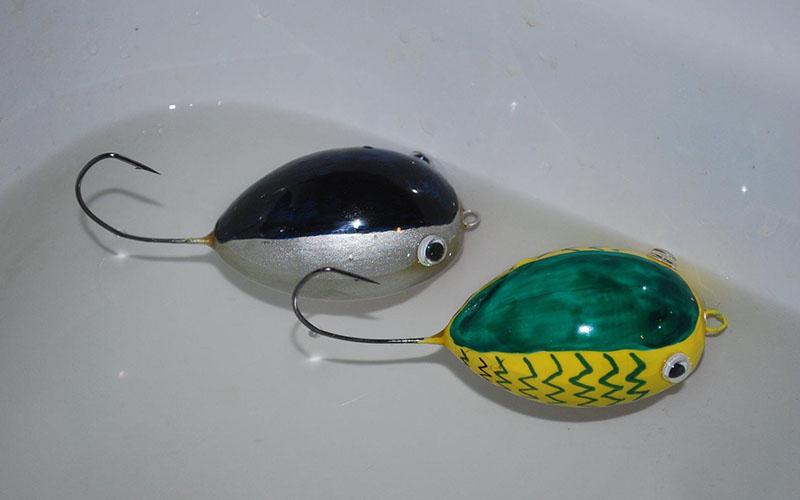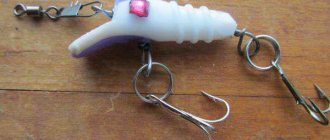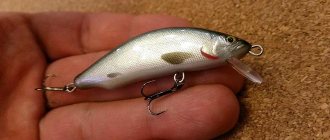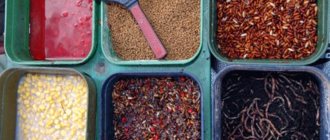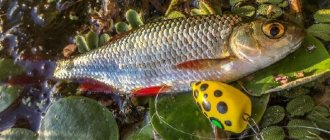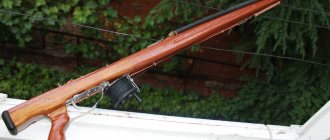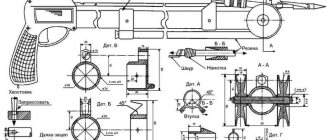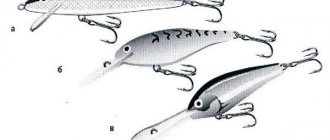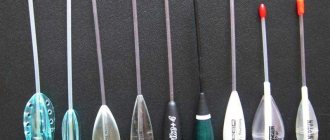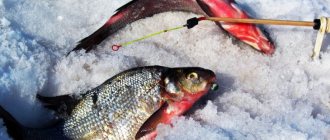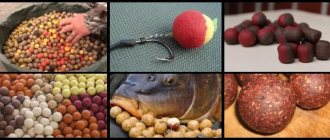What is a popper
Popper is a bladeless surface wobbler with an elongated or slightly rounded body. Its distinctive feature is a funnel-shaped depression in the head part (“spitter”), making it look like a small fish with a wide open mouth. When retrieving, this depression creates characteristic gurgling sounds - as if a fry on the surface is grabbing insects (mosquitoes, midges) that have fallen into the water or are flying low above it.
The length of this bait ranges from 3-4 to 12-15 cm, weight - from 2-3 to 18-20 grams.
The wobbler is equipped with two triple or double hooks with a soft edge. The hooks are located on wire loops-suspensions on the abdomen, in the tail part. The color of the wobbler can be either natural, like a fry of perch, rudd or roach, or bright unnatural colors (acid green, yellow). The wobbler is attached to the fishing line or the latch of the metal leash using a loop with a ring located inside its nose recess.
These fish are made from durable plastic, balsa. Most models have a sound chamber inside the body with small balls, which, when the wobbler plays, create sounds that attract predators.
On a note
When looking for the best popper, most anglers prefer hard plastic models. This material, unlike balsa wood, is stronger, more durable, and less scratched when grabbed by a predator.
Popper classification
A variety of such surface baits is classified depending on the location of the load - the shift of the center of gravity to the tail, head part of the wobbler, or its uniform distribution throughout the body of the bait.
Based on this feature, these wobblers are divided into:
- Front-loaded - most of the weight in such baits is concentrated in the head part.
- Rear-loaded - the main part of the weight is shifted to the tail of the popper.
- Lures with weights distributed evenly throughout the body.
Check the distribution of the load by lowering a popper attached to a fishing line into an aquarium or container with clear water. Based on which part of the wobbler is the most recessed, it is determined which of the types described above it belongs to.
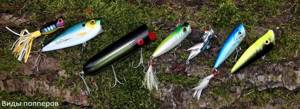
On a note
The division of these plastic fish into floating or sinking poppers is incorrect, since these bladeless wobblers do not dive deeper than 10-15 cm.
How to make a popper with your own hands
Many fishermen dream of a catchable bait for successful fishing.
For these purposes, manufacturers offer high-performance poppers. However, they are quite expensive. Not everyone wants to spend money on them, because every cast of a fishing rod is a risk of losing precious bait. Therefore, a considerable number of fishermen are looking for ways to manually make bait at minimal cost that fish will bite on very often. Making a popper is, in principle, not difficult. First you need to decide what material it will be made from, and then you can get to work.
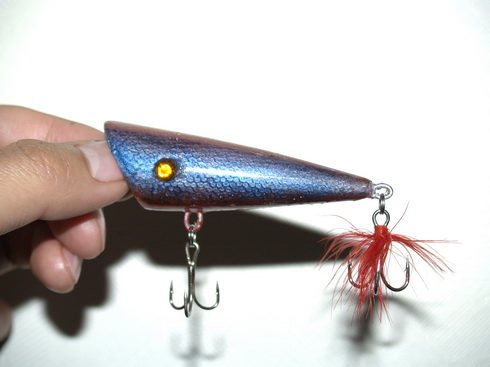
Cork popper
From items available in any home and an ordinary wine bottle stopper, etc. You can make a pretty catchy popper for fishing. For this you will need:
- the cork itself;
- paints (you can use nail polish or varnish);
- sinker (preferably fishing);
- regular paper clip;
- construction sandpaper;
- super glue or any equivalent.
The following tools will also be useful:
- mini-drill (you can use a screwdriver with a screw-type attachment);
- a vice or other fastening device;
- awl;
- stationery knife.
The most important thing in making this bait is to give it a natural shape. After this, the cork must be sanded. To do this, a plug is placed on the self-tapping screw. Using a screwdriver, the self-tapping screw is rotated, and processing is carried out during rotation.
Next you need to drill a small hole for the sinker. The size and shape of the hole depend on the sinker chosen. The main thing is that the overall design of the future bait does not fall apart. It is advisable to choose a sinker the size of one-fourth of the cork, no more. The weight of the sinker is also important.
Make it a rule, on every fishing trip, the first thing you do is start.
You should choose sinkers weighing at least two and no more than four grams. We fix the sinker tightly with glue. The last stage is painting the artificial bait. Most fish species don't care what color their food is. The main thing is that the homemade product is noticeable. Therefore, it is better to paint it in bright colors that are visible on the surface of the water. So, the cork popper is ready.
Choosing fishing gear
Rod and reel
For fishing with such a wobbler, use a rod with the following characteristics:
- Length - 2.1−2.4 meters.
- The build is super fast.
- Test - 10−30 grams.
- The blank material is graphite.
Jig blanks with a thin, sensitive tip are not suitable for fishing with poppers. The spinning rod for this bait is chosen from twitching models, with a hard, durable whip, a comfortable spaced handle made of EVA, and a reliable reel seat.
An inertia-free reel installed on a spinning rod must have the following characteristics:
- Forest capacity (size) - 2500−3000.
- Gear ratio - 5.0−5.2:1.
- The number of bearings is at least 4-5 installed in the transmission mechanism, line roller, knob.
- Body material: aluminum alloy, carbon fiber.
- Weight - no more than 300 grams.
fishing line
Fishing tackle for popper fishing is equipped with a bright-colored braided cord with a cross-section of 0.08−0.12 mm. Monofilament fishing line with a thickness of 0.18−0.22 mm is used when fishing for perch in small ponds with a maximum casting distance of no more than 15 meters.
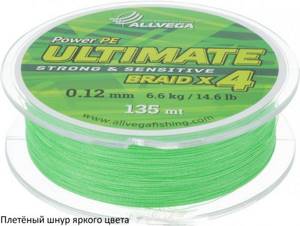
On a note
The bright color of the cord is necessary in order to see in low light conditions where the bait is located, to which place it goes at the end of the line.
Fishing technique and tactics
Popper fishing techniques and tactics include the correct choice of place and time of fishing, retrieving, hooking, and retrieving.
Choosing a place and time of fishing
The most successful fishing is with bladeless surface wobblers in the summer, from June to the end of August. In autumn, as it gets colder and aquatic vegetation dies off, their catchability decreases significantly, giving way to heavy sinking wobblers, oscillating spoons, twisters and vibrotails.
Such plastic fish are used in reservoirs where other baits will often cling. Such places include:
- Shallow river oxbows and bays overgrown with grass.
- Snagged ponds, lakes.
- “Zhabovniki” are shallow lakes heavily overgrown with grass, bets.
- River sections with weak currents and a large amount of aquatic vegetation on the surface.
Popper fishing is inconvenient and ineffective in clear sections of rivers with medium or fast currents. In such conditions, the wobbler will be strongly carried away by the flow of water and will not animate well.
Wiring Features
When fishing with a popper, use a classic twitching (jerk) retrieve, performed as follows:
- After casting, unwind the slack line and wait for a while until the fish stops creating ripples around itself.
- In order to easily control the wobbler, the tip of the blank is lowered as close to the water as possible.
- After the wobbler has become motionless, they begin to wind the cord with a reel, while making short and sharp jerks with the tip of the rod. Evidence of good wiring is a characteristic gurgling sound and a trail of bubbles left behind the fish.
On a note
The jerk force should be such that the bait does not jump out of the water, but only creates a splash and the necessary sound. Wiring consisting of jerks and pauses lasting 2-3 seconds is also possible. The wiring of the popper depends on the activity of the fish: for a sluggish and inactive predator, wiring with jerks and long pauses is used. When catching active fish, they use a retrieve in which each jerk alternates with a short pause or without it at all.
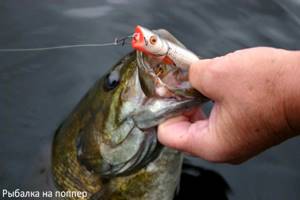
Hooking and landing
A bite on such a surface wobbler is felt not only “in the hand”, but is also visible visually by the splash next to the wobbler. In this case, they hook with a sharp and short jerk. They land the fish carefully, not giving it the opportunity to drag the wobbler into the bushes, grass, or snags.
Easy to make pop-poppers
Spring is coming to an end, which means that the fish have spawned and the bans for fishermen are lifted. This time we will study the strategy of how to catch rudd and other other fish using a spinning rod. And we will use poppers, or rather pop-poppers. According to many fishermen, such weapons are number one when catching rudd; moreover, this fishing method is sporty and very interesting.
The popla popper works much like a regular popper, except it doesn't have hooks. The task of the gear is to attract the attention of the fish, which always goes to the splashes of a beetle that has fallen into the water, to the feeding areas of other fish, and so on. In any case, the fish always looks at the surface of the water if something happens there.
Together with the tees, a leash with a hook is installed on the pop-popper, and maggots, bloodworms, dough or everyone’s favorite worm are used as bait. When a fish bites, the popper works like a float.
How to make a popper yourself
You can make a popper with your own hands from such simple materials as a wine cork or wood.
From the traffic jam
A homemade popper is made from a wine cork using the following technology:
- At the ends of the cork, lines are drawn through the center with a marker.
- A frame consisting of three hanging loops - front, back and abdominal - is bent from steel wire.
- The loops are fixed with a winding of thin copper wire.
- The cork is sawed lengthwise to the middle.
- A wire frame is placed in the cut.
- In the cut, 3-4 notches are also made for loading.
- Lead pellets weighing 0.7-1.0 grams are inserted into the recesses.
- Fine shavings are poured into the cut and thoroughly impregnated with waterproof transparent glue.
- After the glue has dried, the body of the popper is treated with a transparent waterproof varnish.
- A hole is made in the beer cork of such a diameter that the front loop of the wire frame passes through it.
- The end of the bait and the reverse (flat) side of the beer cap are coated with durable epoxy waterproof glue.
- Glue the beer cap to the body of the bait.
- Two artificial eyes are glued to the sides of the bait.
You can see the bait making process more clearly in the video below:
Made of wood
The process of making a popper from wood is as follows:
- A birch block 5-7 cm long and 1.5-2 cm in diameter is ground to a cone.
- The wide (head) part is cut at an angle of about 300.
- A recess is made at the end of the wide part - a “spitter”. To do this, first scrape out a small hole with a knife, widen it with a drill and sand it with coarse-grained sandpaper.
- A cut is made on the belly of the bait.
- A wire frame and loading pellets are inserted into the cut.
- Wood shavings mixed with waterproof glue are poured into the cut.
- After the glue hardens, the abdomen is treated with sandpaper.
The entire manufacturing process is clearly shown in more detail in the following video:
On a note
More accurate dimensions and drawings for fishing and making such bait can be found on fishing forums.
Hooks
A homemade popper is equipped with strong and large triple, less often double hooks No. 3−2.
Lure coloring
The color does not affect the catchability of the bait in any way - the predator sees it from below and does not react even to the most realistic colors. The color of the wobbler is more important for the angler himself, who needs to see the bait from a long distance in twilight, ripples or waves. Therefore, the best popper should be painted in colors that are visible on the water - green, white, red, etc.
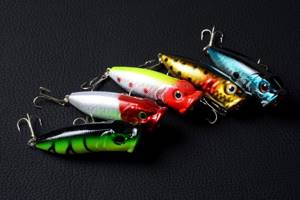
Materials and accessories
To make a popla popper with your own hands, you will need the following:
- Natural cork
- Paper clip
- Fishing sinker pellet
- Sandpaper
- Glue "Moment"
- Nail polish
Plus, you need to prepare some tools, namely:
In addition, you will need electronic kitchen scales and, if available, an electric sharpener, which can be replaced with a manual one.
Manufacturing process
Making a popper starts with giving it a shape. To do this, cut off all excess from the cork using a knife. But to do this, you need to decide on the size. It is not worth making a bait longer than 30 mm. The classic dimensions are as follows: the length of the large popper is exactly 30 mm, the length of the small one is 23 mm.
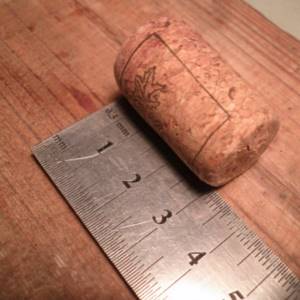
This, of course, is not a dogma; experiments are not forbidden, even encouraged. It is possible that you will be able to make an even more catchy bait, but you need to build on these numbers.
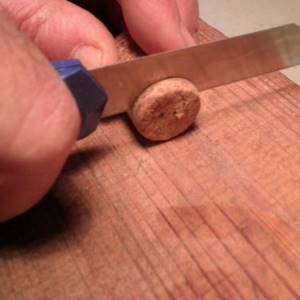
So, we cut off the excess length and make a notch on the side of the cut edge. It is needed so that when wiring the popper, you get a characteristic “chock”. A smooth recess is obtained using a large-diameter drill. It is done by hand.
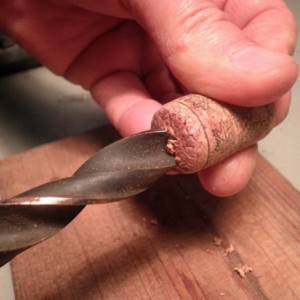
The recess is ready:

Now you need to give the workpiece a shape. To do this, cut off all excess from the edge without a notch:
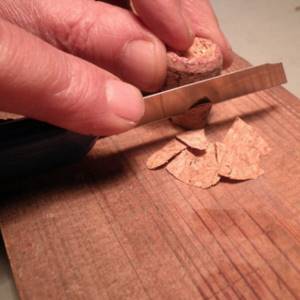
We get this semi-finished product:
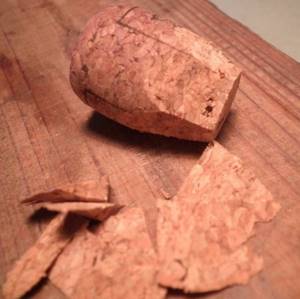
After the shape of the pop-popper has emerged, the surface of the cork must be treated with coarse sandpaper. To do this, we take a drill, clamp it in a vice and make a device like this, where the self-tapping screw is designed to place a workpiece on it, and the plug serves as a kind of limiter.
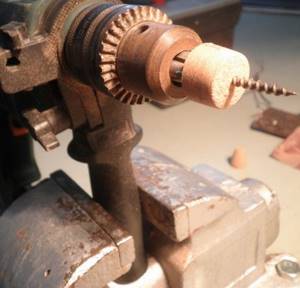
We screw the plug onto the self-tapping screw, take the sandpaper in our hands and start the “installation”. After processing with coarse sandpaper, sand the surface with fine sandpaper.
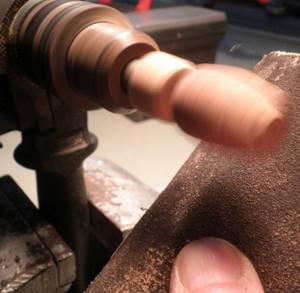
The result is something like this:
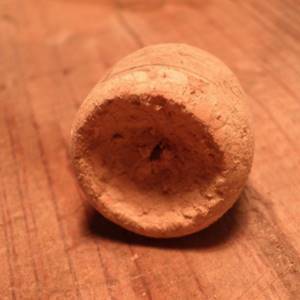
Let's continue making the popper, namely, add weight to it and make an attachment for the main fishing line and leash. First - fastening. To make it you will need a regular paper clip.
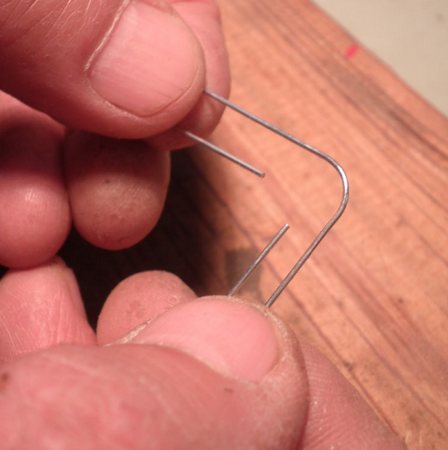
- After some simple manipulations, the paper clip looks like this:
- We make a longitudinal cut to the center and insert the fastener.
- Fill the gap with Moment glue and clamp it in a vice.
After the glue has dried, you can continue making your own popper. Now, using a drill suitable in size to the diameter of the weight that we will insert, we make a hole. Again - manually.
We drip glue into it and place a weight of suitable weight.
The question arises: what weight to choose? We assume that the weight of a small popper is 1.8 g, a large popper is 3.7 g. Electronic kitchen scales are suitable for weighing.
Please note that this is the total weight of the plug with fastening and the weight, so do not forget to place the workpiece itself on the platform. To achieve a flat surface, the protruding part of the weight will have to be removed, and this must also be taken into account when weighing.
The practice of using homemade poppers shows that apothecary precision is not required here, but you still need to strive for the ideal.
To remove excess it is very convenient to use an electric sharpener.
We also place the weight on the glue and wait until it dries. With some skill and partial mechanization of labor, making a popper popper blank takes about half an hour.
Then you can turn to the services of a home designer in the image of your wife or daughter, or decorate the bait yourself. This is done using nail polish, the main thing is that it does not give a transparent effect when applied.
Buy a thick varnish, then the color will be the same as it looks in the bottle. A few words about choosing colors.
The fish don't care what type of popper it is, so make it so that it is clearly visible even on long casts. If the fishing takes place in an overgrown area of the reservoir, and it is precisely for such places that the pop-popper is intended, then it should definitely not be green. The best option is red or yellow, and white is perfect for fishing at dusk.
Source: https://samrybak.ru/popla-popper-svoimi-rukami.html
How to choose a popper
Catchable poppers are selected according to length, type of load, based on such criteria as the object being fished and casting distance.
To size
- With a bait size of 5-6 cm, the angler can count on catching large perch, small pike, and asp.
- For medium and large pike and asp, the most suitable baits are those with a length of more than 7 cm.
By casting distance
- If it is necessary to cast over long distances, rear-loaded baits are used.
- The best popper for short-range fishing should have a weight located at the front or evenly distributed throughout the body.
On a note
The shape of the popper affects its casting distance. Lures with an elongated body can be cast further than those with a more rounded body.
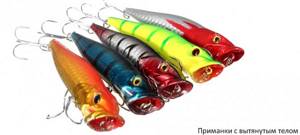
Homemade transparent from a syringe
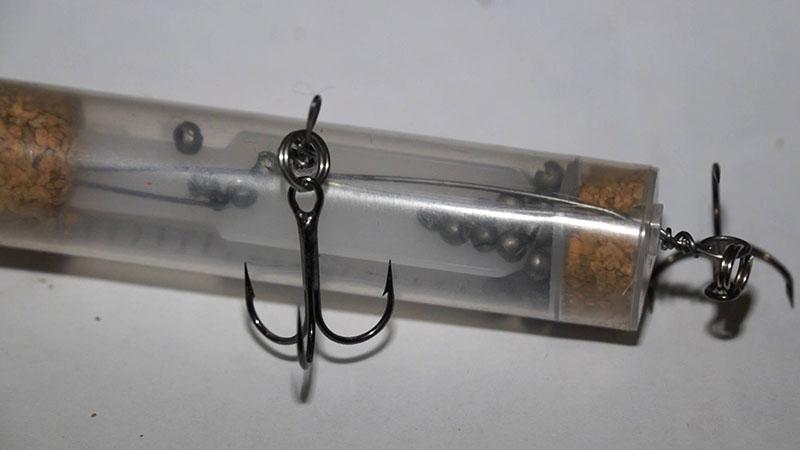
Another interesting homemade popper can be made from a plastic syringe . At the pharmacy you can purchase several disposable syringes of different sizes and make poppers of various sizes from them. The tools and materials that you need to have on hand when making this bait are the following: several wine corks, soft steel wire, small ball bearings, a sharp knife, pliers and wire cutters, a drill, tees with winding rings.
Let's look at step-by-step instructions for making a popper from a syringe:
- First, the syringe is disassembled into parts, the nose and ends at the stem are cut off with a knife.
- Using a knife, two cylinders are cut out of the cork and ground on all sides so that their diameter matches the diameter of the inlet holes of the syringe. For the front part of the syringe, a cylinder is made approximately twice as long as for the back.
- The wire is pierced into one of the plug cylinders, then it is inserted into the remaining part of the rod, and finally the second cylinder is threaded onto it. Before putting on the second barrel, metal balls are poured into the body of the syringe.
- The entire structure is brought to the point where all its parts fit tightly together.
- A hole is drilled in the front of the syringe opposite the plug cylinder and a wire loop for the front tee is inserted there.
- Loops are also made at the free ends of the wire.
- All that remains is to attach the winding rings with tees and the original bait is ready.
- There is no need to paint the popper with a syringe.
The three considered options for making poppers are the most common among anglers who are interested in creating homemade baits. You can also make mini poppers out of bottle caps (a champagne cork will work) and only have one hook at the back. To make such baits, as a rule, drawings are not required.
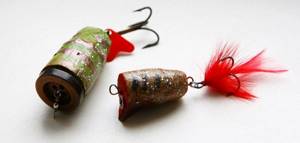
A lover of homemade products may be interested in an analogue of the “Croatian egg” - a popper with one tightly mounted rear hook with a fly - a bait that has 100% passability through thickets of aquatic vegetation.
